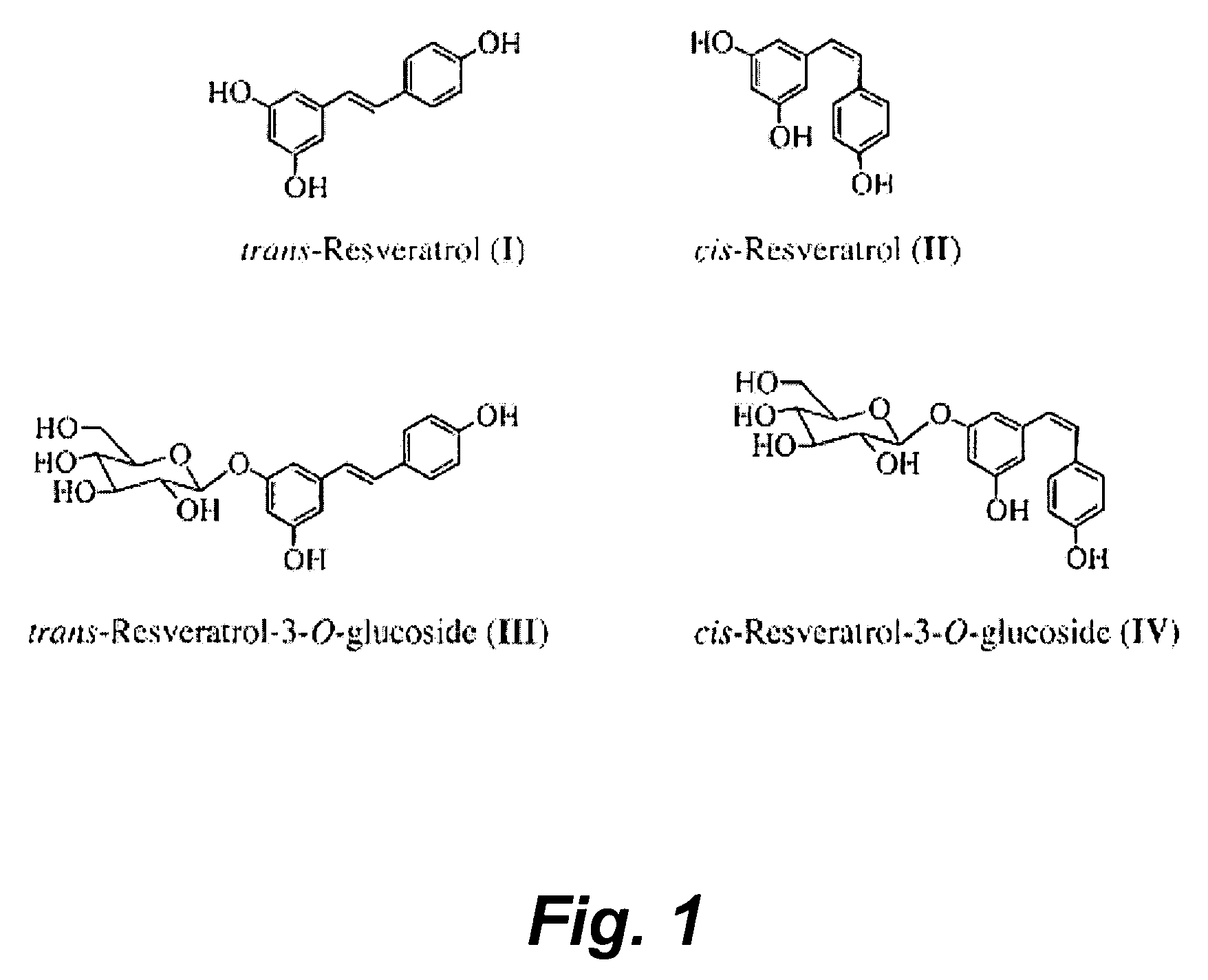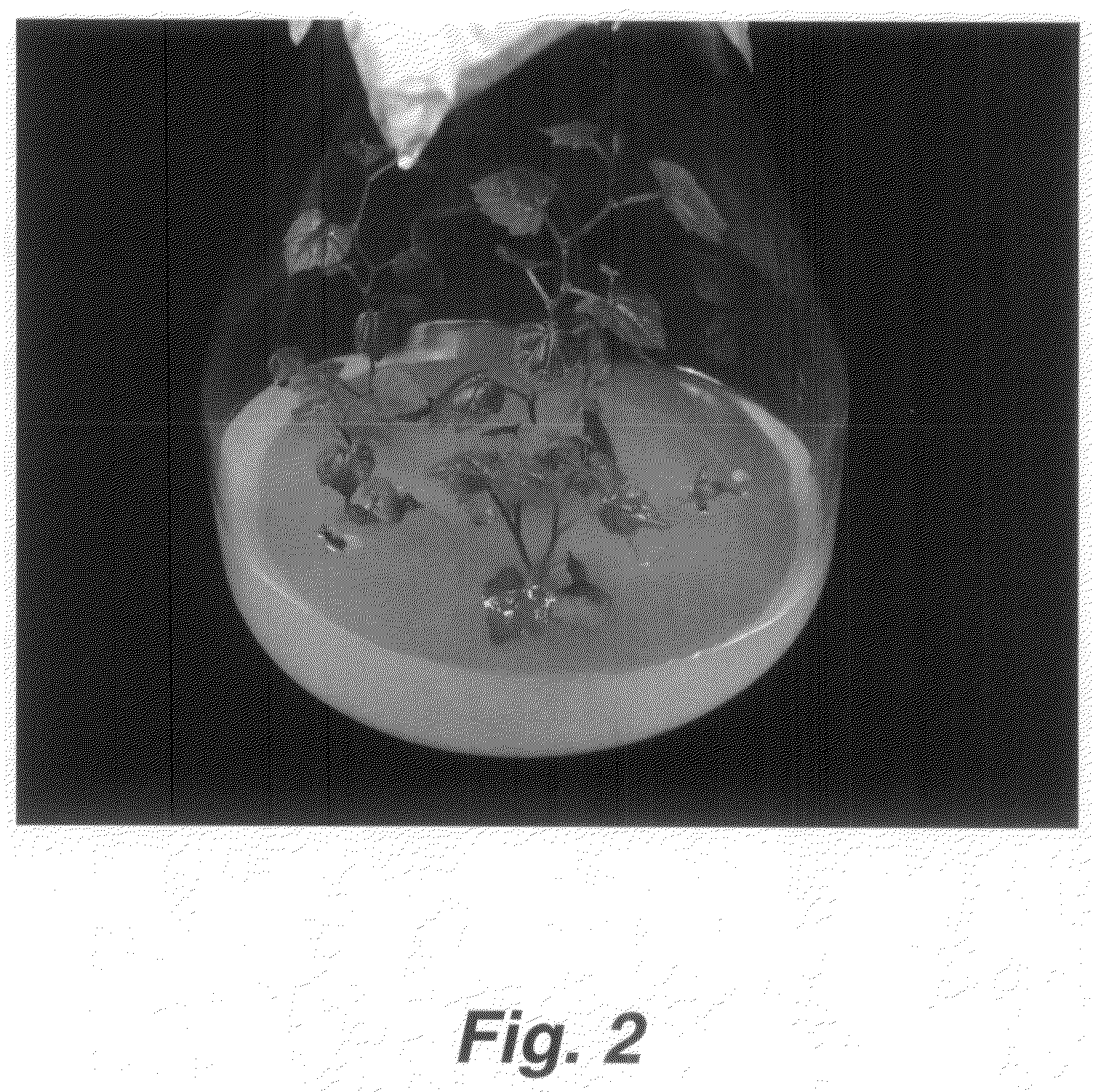In vitro resveratrol-rich callus tissues derived from vitis thunbergii Sieb.et Zucc and method for producing the same
- Summary
- Abstract
- Description
- Claims
- Application Information
AI Technical Summary
Benefits of technology
Problems solved by technology
Method used
Image
Examples
example 1
Material and Methods
Plant Materials
[0055]Vitis thunbergii Sieb. et Zucc. plants were obtained from the Tao Yuan Agricultural Improvement Farm. Plant tissues were sterilized and placed into various culture media. The shoots of the V. thunbergii plants were induced and developed.
[0056]The shoots were cultivated in a solid medium which contained MS salts and a carbohydrate (such as myo-inositol or sucrose or a mixture thereof) with no PGRs (i.e., a MS0 medium). In about 2 months, a complete plantlet was produced from each shoot, as shown in FIG. 2. The plantlet was sub-divided into leaf, stem, and petiole three different tissue explants for induction of the in vitro resveratrol-rich callus tissue.
Culture Medium Various plant growth regulators (PGRs) and other cultural factors were added to the tissue culture medium containing MS salts as shown in Table 1. Unless otherwise noted, all media were supplemented with 30 g / L sucrose, 10 mg / L thiamine-HCl, 1 mg / L pyridoxine-HCl, 1 mg / L nicotin...
example 2
Differences in Calluses Produced by Different Explants
[0069]The leaf, petiole (the base of leaf), and stem of in vitro cultured Vitis thunbergii Sieb. et Zucc. plant were tested as explants to induce calluses. The leaf tissue was not a good explant for induction of calluses. As shown in FIG. 6, after one month in the tissue culture system containing a ½ MS medium with 1.5 mg / L of NAA, and 0.5 mg / L of BA, most of the leaf explants only generated small calluses or roots.
[0070]When stem (FIG. 7) or petiole (FIG. 8) explants were used, if the tissue culture media did not contain NAA, all explants became brown with no callus generation (FIGS. 7-8, N1-1˜N1-5). If the tissue culture media contained NAA in the concentration range of 0.5-1 mg / L and no BA (FIGS. 7-8, N2-1, and N3-1), the petiole and stem segments developed roots instead of calluses. The callus tissue from the stem explant developed in the tissue culture system with the NAA at the concentration of 1.5 mg / L (FIGS. 7-8, N4-1) an...
example 3
Growth Rates and Resveratrol Contents in the In Vitro Resveratrol-Rich Callus Tissues and Their Subcultures
[0072]To study the resveratrol content in the callus subculture, well induced in vitro resveratrol-rich callus tissues from the stem or petiole explants of Example 2 were placed in a fresh culture containing the various solid subculture medium as indicated in Table 3 for about 1 month with the medium changed every two weeks to develop the subculture of the in vitro resveratrol-rich callus tissues. About 1 g of the fresh weight (FW) of the subcultured callus tissues was taken out from the subculture, and analyzed for the resveratrol content. As shown in Table 3, the media containing 1.5 mg / L NAA and 0.5 mg / L BA resulted in the highest resveratrol content in the subculture of the in vitro resveratrol-rich callus tissue from either the stem or the petiole explant. The control tissue was a callus tissue after being subcultured in an MS medium containing 1.86 mg / L of NAA and 0.22 mg...
PUM
 Login to View More
Login to View More Abstract
Description
Claims
Application Information
 Login to View More
Login to View More - R&D
- Intellectual Property
- Life Sciences
- Materials
- Tech Scout
- Unparalleled Data Quality
- Higher Quality Content
- 60% Fewer Hallucinations
Browse by: Latest US Patents, China's latest patents, Technical Efficacy Thesaurus, Application Domain, Technology Topic, Popular Technical Reports.
© 2025 PatSnap. All rights reserved.Legal|Privacy policy|Modern Slavery Act Transparency Statement|Sitemap|About US| Contact US: help@patsnap.com



